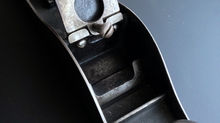Which Came First - Chicken or the Egg? (or Mr. Shaw vs. Mr. Schade)
Sargent No 7 Shaw's Patent 7 3/4” X L 1 7/8”; W, 2 lb 6 oz; 1.078kg
If you know much about bench planes you are undoubtedly familiar with Stanley and their attempt to corner the market with the Bailey line. Clean, basic, good performance and relatively inexpensive for the time period win which it was produced. In 1898 Stanley came out with the Bedrock, an improvement to Bailey? Well, it was certainly more expensive but more importantly, in 1911, Stanley employee, Edmund Schade, patented the “three screw” frog adjusting design that allowed forward/backward frog adjustment by means of without removing the lever cap and iron assembly. Quite innovative, or was it?

As it turns out, a guy by the name of John H. Shaw who was working for Sargent Tool Company patented a similar design that actually predates Schade's Bedrock patent by 6 years, (July 3, 1905 to be exact - patent number 824954). Though the patent date is earlier, the plane wasn't mass produced or heavily marketed until about 1910 and the Bedrock part deux about a year later. Strong evidence indicates that the earliest examples of the Shaw's patent only came in an 8 inch size and are listed in Sargent's literature as model 6408. It's believed that 6408 production began around 1906 or so. It's also interesting to note that many early Shaw's Patent examples sport a plain lever cap while the later ones, post 1910, a “VBM” embossed cap. This is the point that Sargent began using the embossment on many of its production line. It's therefore plausible or even likely that sizes other than the 6408 were indeed produced prior to 1910. (Don Wilwol; Time Tested Tools)

Shaw's design differed from Shade's in a couple ways. First, 3 screws secure the frog to the base, one in the front, to help secure and align it in relation to the mouth and two clamping screws, one on each side of the back of the frog. A center adjusting screw hole machined into the bottom of the frog and parallel to the sides, receives a collared adjusting screw with the upper portion of the screw, (the collar) fitting neatly into a flange cast into the rear of the frog receiver. Much like the yoke screwed onto the bottom of a Stanley plane, except in reverse. Turning the screw moves the frog fore and aft keeping the iron consistently exposed through the mouth and maintaining depth of cut while decreasing the mouth opening in relation to the cutting edge. More simply, the Shaw patent design allowed the frog to adjust parallel to the sole, so readjusting the frog did not require readjusting the cutter. The Bedrock, on the other hand adjusts at a horizontal angle, (up and down the ramp) so any adjustment of the frog requires a readjustment of the cutter depth. All very complex sounding but quite simple in design. It's a great idea but with a couple of drawbacks.

Like Schade's design, the cutter assembly does not have to be removed to loosen the frog clamping screws but are sure a pain to access because of their awkward positioning in relation to the upper portion of the frog. Takes a long, thin shafted screwdriver to reach them. Besides that, the front screw can't be over-tightened since that would hold the frog too tightly in place and defeat the purpose of the design. The plane of the frog receiver is flat in comparison to the Bedrock's ramped design and the contacting surface area is less. But with all the securing screws it is very solid, minimizing chatter.

I love the look of the No 7, with the beautiful mahogany beaded knob and “chunky” tote. The frog adjusting screws make it look really complex, even though it's not. The “crosshatch” knurled brass plated depth adjusting knob is conveniently placed though a bit large for the available space on the 7. It's much more usable with the larger sizes. The plane seems to me a bit more stout than a comparable sized 602 Bedrock but in addition to the difficulty with adjustment, performance seems to fall a bit short in comparison as well. Overall, tuning this plane up is as easy (or as difficult) as any other No 2 size I've worked on. My biggest complaint is with the difficulty in sharpening the standard equipment early Sargent cutter. Compared to Stanley's production irons at the time, this one really kind of sucks. I found it very hard to get a consistent and sharp edge on the bevel, perhaps because of the steel Sargent was using. Of course there is always the possibility of operator malfunction but I've successfully sharpened hundreds of plane irons over the past several years and have consistently found the early Sargent irons some of the most difficult to work.

In the greater scheme of early 20th Century “planedom” Sargent made very good planes and the No 7 Shaw's seems to be no exception. In fact, perhaps for some back in 1910, a good choice over the more popular Stanley Bedrock. However, I don't think tolerances, fit and finish is quite as good as the standard Bailey and certainly the Bedrock outshines in that respect as well. Performance also has to favor the Stanley products if only because of the iron. Perhaps a Stanley substitute or even one of modern production would compare more favorably. But if you are looking for a user No 2 size plane, go with something a bit less rare, even a Stanley or a Lie Nielson, for a lot less money and a lot less risk. The Sargent No 7 Shaw's Patent is a collector's item, not a bench user so why not just leave it at that? bench user so why not just leave it at that?































